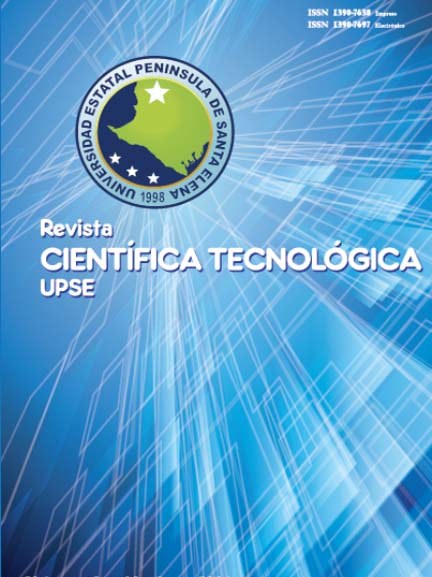Modelling to Ceratitis capitata(Diptera: the pritidae) for Ecuador
DOI:
https://doi.org/10.26423/rctu.v2i3.54Keywords:
fruit fly, ecoclimatic index, potential distribution Climexmodel,, climate change scenarioAbstract
This study determined the potential distribution of C. capitata under current climate conditions and a climate change scenario (A1B-2030) for the Ecuador using the CLIMEX model version 3. The model used physiological parameters of C. capitata and global meteorological data, to build an Ecoclimatic Index (EI), which described the very favorable areas (EI > 30), less favorable areas (EI < 30) and less favorable areas (EI = 0) for the distribution of C. capitata throughout the year. It was estimated that the percentage of very favorable areas (EI > 30) of C. capitata is 47.73% in current climate conditions and 33.3% in the scenario (A1B-2030). In addition, it was estimated that the percentage of less favorable areas (EI < 30) is 47.61% in current climate conditions and 62.17% in the scenario (A1B-2030). The areas with zero probability for establishment of C. capitata is 4.65% for current climate conditions and 4.80% for the scenario (A1B-2030).
Downloads
References
AGROCALIDAD,2013. Proyecto Nacional de Manejo de Moscas de la Fruta. Aprobado por Decreto Ejecutivo el 17 de abril del 2014. Ecuador. 107 p.
APHIS, 1992. Risk assessment, Mediterranean fruit fly. Washington D.C.: Planning and Risk Analysis Systems. Policy and Program Development. Animal and Plant Health Inspection Service USDA.
CareyJR.,1996. The Incipient Mediterranean Fruit Fly Population in California: Implications for Invasion Biology. Ecology 77: 1690–1697 doi:10.2307/2265775.
CrossE.,2004. Mediterranean fruit flies attempt to sneak in—again. Cust Bord Prot Today.
DeMeyer M., Robertson M.,PetersonA.,MansellM.,2008.Ecological niches and potential distribution of Mediterranean fruit fly (Ceratitis rosa). J Biogeogr 35: 270-281. Doi: 10.1111/j.1365-2699.2007.01769.x.
INAMHI,2013. Atlas hidrológico y metereológico estudiantil 2013. http://issuu.com/inamhi/docs/atlas_estudiantil
KriticosD.,Webber B., Leriche A.,OtaN.,Macadam I.,Bathols J., and Scott J.,2012. CliMond: global high-resolution historical and future scenario climate surfaces for bioclimatic modelling. Methods in Ecology and Evolution 3: 53-64.
Liquido N., Cunningham R.,Nakagawa S.,1990.Host Plants of Mediterranean Fruit Fly (Diptera: Tephritidae) on the Island of Hawaii (1949–1985 Survey). J Econ Entomol 83: 1863–1878.
MunizM., ZalomF.,1997. Developmental rate and number of generation estimates for Ceratitis capitata (Wiedemann) in fruit growing regions of California Bulletin OILB/SROP 20 55-66 USA, California. 15p.
Siebert JB., Cooper T., 1995.If medfly infestation triggered a trade ban: Embargo on California produce would cause revenue, job loss. Calif Agric 49: 7–12 doi:10.3733/ca.v049n04p7
SutherstG.,2003. Prediction of species geographical ranges. Journal of Biogeography 30: 805–816.
SutherstG.,Maywald G.,KríticosD.,2007. CLIMEX version 3: user’s guide. Australia, Hearne Scientific Software, CSIRO. 131 p.
Szyniszewska, A. Tatem, A. 2014. Global Assessment of Seasonal Potential Distribution of Mediterranean Fruit Fly,Ceratitis capitata(Diptera: Tephritidae). PLoS ONE 9(11):e111582. doi:10.1371/journal.pone.0111582
VanDriesche R.,Hoddle M.,CenterT.,2007. Control de Plagas y malezas por enemigos naturales. Trad. Ruíz, E; Coronada, J y Álvarez, J. Estados Unidos. 751 p.
VargasR., Walsh W., Jang E; ArmstrongsJ., and KanehisaD.,1996. Survival and development of immature stages of four Hawaiian fruit flies (Diptera: Tephritidae) reared at five constant temperatures. Annals of the Entomological Society of America 89: 64-69.
Vera T., Rodriguez R.,SeguraD.,CalderaJ.,SutherstR.,2002. Potential Geographical Distribution of the Mediterranean Fruit Fly, Ceratitis capitata (Diptera: Tephritidae), with Emphasis on Argentina and Australia. Environmental Entomology. 31(6):1009-1022
VenerosJ.,2014. Distribución potencial de Phthorimaea operculella (Zeller), bajo condiciones del clima actual y un escenario de cambio climático. Tesis M.Sc. Ciencias Ambientales. Lima. Universidad Agraria La Molina. 152 p.
WoodwardF.,1988. Temperature and the distribution of plant species and vegetation. In: Long SP and Woodward FI (eds), Plants and Temperature. Society of Experimental Biology by The Company of Biologists Limited. Cambridge 42: 59-75 p.
Downloads
Published
Issue
Section
License
El titular de los derechos de autor de la obra, otorga derechos de uso a los lectores mediante la licencia Creative Commons Atribución-NoComercial-CompartirIgual 4.0 Internacional. Esto permite el acceso gratuito inmediato a la obra y permite a cualquier usuario leer, descargar, copiar, distribuir, imprimir, buscar o vincular a los textos completos de los artículos, rastrearlos para su indexación, pasarlos como datos al software o usarlos para cualquier otro propósito legal.
Cuando la obra es aprobada y aceptada para su publicación, los autores conservan los derechos de autor sin restricciones, cediendo únicamente los derechos de reproducción, distribución para su explotación en formato de papel, así como en cualquier otro soporte magnético, óptico y digital.












